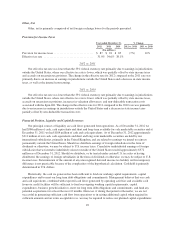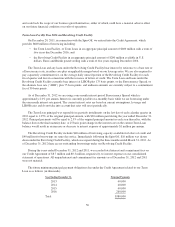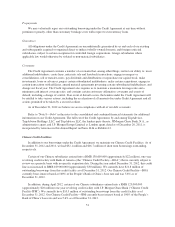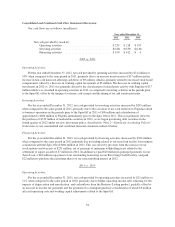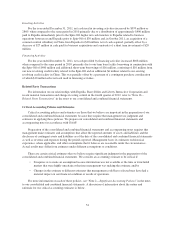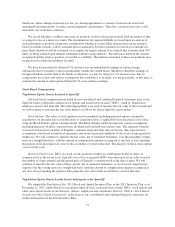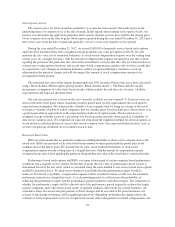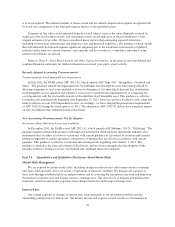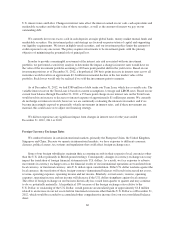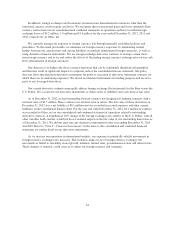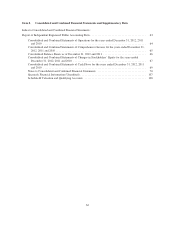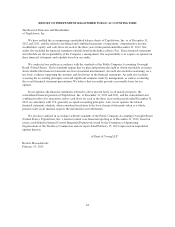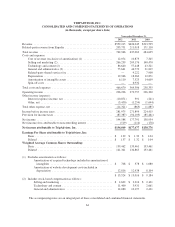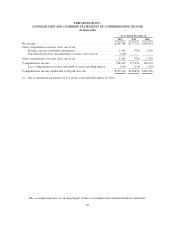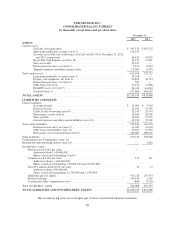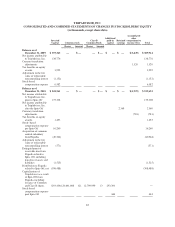TripAdvisor 2012 Annual Report Download - page 68
Download and view the complete annual report
Please find page 68 of the 2012 TripAdvisor annual report below. You can navigate through the pages in the report by either clicking on the pages listed below, or by using the keyword search tool below to find specific information within the annual report.Stock Option Activity
The exercise price for all stock options granted by us to date has been equal to the market price of the
underlying shares of common stock at the date of grant. In this regard, when making stock option awards, our
practice is to determine the applicable grant date and to specify that the exercise price shall be the closing price
of our common stock on the date of grant. Stock options granted during the year ended December 31, 2012 had a
term of ten years from the date of grant and generally vest over a four-year requisite service period.
During the year ended December 31, 2012, we issued 3,650,814 of primarily service based stock options
under the 2011 Incentive Plan with a weighted average grant-date fair value per option of $20.36. We will
amortize the fair value, net of estimated forfeitures, as stock-based compensation expense over the vesting term
of four years on a straight-line basis, with the amount of compensation expense recognized at any date at least
equaling the portion of the grant-date fair value of the award that is vested at that date. We use historical data to
estimate pre-vesting option forfeitures and record share-based compensation expense only for those awards that
are expected to vest. Changes in estimated forfeitures will be recognized through a cumulative catch-up
adjustment in the period of change and will also impact the amount of stock compensation expense to be
recognized in future periods.
The estimated fair value of the options granted under the 2011 Incentive Plan to date, have been calculated
using a Black-Scholes Merton option-pricing model (“Black-Scholes model”). The Black-Scholes model
incorporates assumptions to value stock-based awards, which includes the risk-free rate of return, volatility,
expected term and expected dividend yield.
Our risk-free interest rate is based on the rates currently available on zero-coupon U.S. Treasury issues, in
effect at the time of the grant, whose remaining maturity period most closely approximates the stock option’s
expected term assumption. We estimated the volatility of our common stock by using an average of historical
stock price volatility of publicly traded companies that we consider peers based on daily price observations over
a period equivalent or approximate to the expected term of the stock option grants. The decision to use a
weighted average volatility factor of a peer group was based upon the relatively short period of availability of
data on our common stock. We estimated our expected term using the simplified method for all stock options as
we do not have sufficient historical exercise data on our common stock. Our expected dividend yield is zero, as
we have not paid any dividends on our common stock to date.
Restricted Stock Units
RSUs are stock awards that are granted to employees entitling the holder to shares of our common stock as the
award vests. RSUs are measured at fair value based on the number of shares granted and the quoted price of our
common stock at the date of grant. We amortize the fair value, net of estimated forfeitures, as stock-based
compensation expense over the vesting term on a straight-line basis, with the amount of compensation expense
recognized at any date at least equaling the portion of the grant-date fair value of the award that is vested at that date.
Performance-based stock options and RSUs vest upon achievement of certain company-based performance
conditions and a requisite service period. On the date of grant, the fair value of performance-based awards is
determined based on the fair value, which is calculated using the same method as our service based stock options
and RSUs described above. We then assess whether it is probable that the performance targets would be
achieved. If assessed as probable, compensation expense will be recorded for these awards over the estimated
performance period on a straight line basis. At each reporting period, we will reassess the probability of
achieving the performance targets and the performance period required to meet those targets. The estimation of
whether the performance targets will be achieved and of the performance period required to achieve the targets
requires judgment, and to the extent actual results or updated estimates differ from our current estimates, the
cumulative effect on current and prior periods of those changes will be recorded in the period estimates are
revised, or the change in estimate will be applied prospectively depending on whether the change affects the
estimate of total compensation cost to be recognized or merely affects the period over which compensation cost
58



